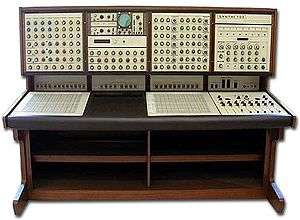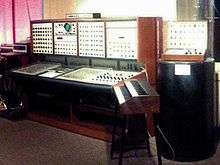EMS Synthi 100


The EMS Synthi 100 was a large analogue synthesizer made by Electronic Music Studios (London) Ltd. It was released in 1971 and cost £6,500. Exactly 40 units were built.[1]
The Synthi 100 was developed from a combination of three VCS3 systems, ending up with 12 VCOs, two keyboards (each of it duophonic, making it possible to play four voices simultaneously), and a 3-track 256-step monophonic digital sequencer. Two 60 × 60 matrixes were used to connect the different modules by using patch pins. The keyboard spread could/had to be adjusted, making it difficult to play a tuned temperated scale for a longer time, but allow for alternative tunings easily.
The sound of the Synthi-100 was subtly distinct from the VCS3. Both filters and oscillators were much more stable in the Synthi-100. The VCS3, however, was very sensitive to temperature changes, so it required repeated re-tuning.
The Synthi 100 also had an add-on computer interface known as "Computer Synthi" which contained a PDP-8 minicomputer and 4Kb of random access memory. It featured an LED display, twin digital cassettes, Two 24 × 60 matrix patchboards, and a switch button control panel. Three were built.
Also the Vocoder 5000 (Studio Vocoder) was available as a separate module installed into the Synthi 100. It contained a 22 band filter, 22 × 22 matrix patchboard, mic/line inputs, two oscillators and noise sources, frequency shifter, pitch to voltage extractor, and a spectrum display driver.
In September 2016 Engineers Australia awarded an Engineering Heritage Marker to a Synthi 100 that had been restored at Melbourne University.[2]
Users
The Synthi 100 owned by Jack Dangers can be heard being used extensively on electronica group Meat Beat Manifesto's album R.U.O.K.?.[3] Many photos from that album's CD sleeve are close-up photos of the Synthi 100's control panels and displays. It was claimed that his unit was the only one still in working condition at that time.
A Synthi 100 (formally from Melodia Radio) is on display at the National Music Centre in Calgary, Canada.[4] Until recently The Music Department of the University of Saskatchewan, in Saskatoon, Canada, also possessed a Synthi 100.[5]
The BBC Radiophonic Workshop took delivery of an EMS Synthi 100 modular system in 1970 and dubbed it the "Delaware", after the name of the road outside the studio.[6] Their composer Malcolm Clarke was one of its most enthusiastic users. One of the more notable scores he produced with the Synthi 100 was the incidental music for the 1972 Doctor Who serial The Sea Devils.[7]
The first classical electronic music LP album generated exclusively on the Synthi 100 was released by Composers Recordings, Inc. in 1975. Called "American Contemporary-Electronic Music" (CRI SD 335), it featured full LP side lengths of music from Barton McLean (Spirals) and Priscilla McLean (Dance of Dawn).[8]
The WDR Electronic Music Studio ordered a Synthi 100 in 1973, and it was delivered the next year[9] It was used by Karlheinz Stockhausen in Sirius (1975–77),[10] by Rolf Gehlhaar for Fünf deutsche Tänze (1975),[11] by John McGuire for Pulse Music III (1978),[12] and by York Höller for Mythos for 13 instruments, percussion, and electronic sounds (1979–80).[13]
Billy Corgan, longtime frontman of The Smashing Pumpkins, is also reported to own one.[14]
The University of Osnabrück, Germany, has a Synthi 100 variant labelled "Synthi 200". The same variant was bought in 1973 by the Bulgarian National Radio for the electronic music studio of Simo Lazarov.
Eduard Artemyev, Yuri Bogdanov and Vladimir Martynov used the Synthi 100 owned by Soviet label "Melodia" for their record "Metamorphoses - Electronic interpretations of classic and modern musical works".[15] Also Lithuanian composer Giedrius Kuprevičius for their rock-oratorio "Labour and Bread" (1978) and Estonian composer Sven Grünberg for the soundtrack of "Hukkunud Alpinisti hotell" (The Dead Mountaineer's Hotel) (1979) as mentioned in the title sequence of the movie.
Wolfgang Dauner has extensively used a Synthi 100, e.g., on his Album Changes (1978).[16]
References
- ↑ Graham Hinton (2001). "EMI Synthi Range 1969-1979". Archived from the original on October 31, 2013. Retrieved 2015-04-18.
- ↑ Simon Leo Brown (2016-09-08). "Melbourne's 'Doctor Who' synthesiser EMS Synthi 100 given engineering heritage award". Australian Broadcasting Corporation. Retrieved 2016-09-08.
- ↑ Stephanie Jorgl. "Jack Dangers: Master of Dub Electronica". Retrieved 2009-09-14.
- ↑ National Music Centre Collection Checklist - June 2012 (PDF), Calgary, Canada: National Music Centre, p. 50, retrieved 19 April 2015,
#353: EMS, Synthi 100 - 2 manual (1971-78, S/N 3009) Instrument - Synth
- ↑ http://news.usask.ca/archived_ocn/10-mar-12/campus_oddities.php
- ↑ Steve Marshall (April 2008). "The Story of the BBC Radiophonic Workshop". Sound on Sound. Retrieved 5 June 2012.
- ↑ "Rare Doctor Who-era synthesizer restored after decades in storage". factmag.com. Retrieved 18 April 2015.
- ↑ "Electronic Music". Spirals, Dance of Dawn. New World Records.
- ↑ Marietta Morawska-Büngeler, Schwingende Elektronen. Eine Dokumentation über das Studio für Elektronische Musik des Westdeutschen Rundfunks in Köln 1951–1986 (Cologne-Rodenkirchen: P. J. Tonger, 1988): 22. ISBN 3-920950-06-2.
- ↑ Morawska-Büngeler 1988, 52; Karlheinz Stockhausen, "Sirius, Elektronische Musik und Trompete, Sopran, Baßklarinette, Baß (1975–77)", in his Texte zur Musik 4 (DuMont Dokumente), edited by Christoph von Blumröder, 301–29 (Cologne: DuMont Buchverlag, 1978): 311; Karlheinz Stockhausen, Stockhausen-Kurse Kürten 2000, Kompositions-Kurs über Sirius, elektronische Musik und Trompete, Sopran, Baßklarinette, Baß (1975–77) (Kürten: Stockhausen-Verlag, 2000): 12, 18.
- ↑ Morawska-Büngeler 1988, 55.
- ↑ =John McGuire, "An Electronic Music Project: The Composition of Pulse Music III". Neuland: Ansätze zur Musik der Gegenwart (Jahrbuch) 3 (1983): 252–67 (Bergisch Gladbach: Neuland), online version on Kalvos & Damian website (Accessed 29 April 2014); Morawska-Büngeler 1988, 108.
- ↑ Ralf Gerhard Ehlert, "Die Verwendung elektronischer Klänge in der Musik York Höllers", M.M. Thesis (Cologne: University of Cologne, 1991): §4.1.
- ↑ "synthfool". Retrieved 2009-09-14.
- ↑ Artemiev, Eduard; Bogdanov, Juri; Martynov, Vladimir (1980). Metamorphoses - Electronic interpretations of classic and modern musical works. Melodia.
- ↑ "Dauner with Synti 100 and his son Flo Dauner"..
External links
- Synth Museum article
- Article on the restored 'Digitana' model at sonicstate.com
- Specifications booklet (9.20 MB PDF)
- The EMS SYNTHI BLOG
- Giedrius Kuprevičius